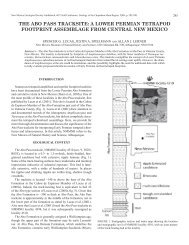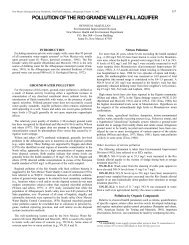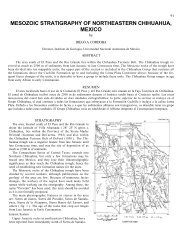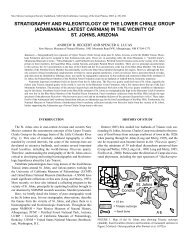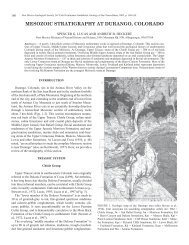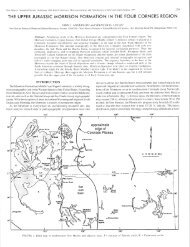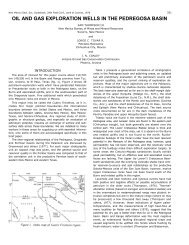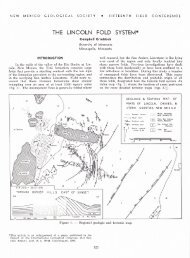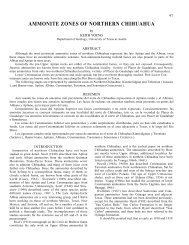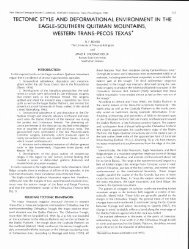When batholiths exploded: The Mogollon-Datil volcanic field
When batholiths exploded: The Mogollon-Datil volcanic field
When batholiths exploded: The Mogollon-Datil volcanic field
You also want an ePaper? Increase the reach of your titles
YUMPU automatically turns print PDFs into web optimized ePapers that Google loves.
120 ELSTON<br />
Retrospect: Rhyolite has the Last Word<br />
Today, the proceedings of the 1947 symposium (Gilluly,<br />
1948) make curious reading. In the entire volume there is not a<br />
single chemical equation, nor is there a phase diagram (not even<br />
by Bowen). In the discussion section, only a junior member of<br />
the audience, Donald E. White (USGS), ventured the opinion (p.<br />
124) that isotopes, “a new and untested approach,” might “conceivably”<br />
throw some light on the problem. Equally remarkable<br />
is the emotional fervor aroused by what is, after all, only a kind<br />
of rock. Sidney Paige (Columbia) remarked (p. 131) that “the<br />
symposium seemed at times to take on a slight flavor of the days<br />
of Werner.” Nobody challenged the supposed scarcity of rhyolite;<br />
even Paige never mentioned the rhyolites he had mapped in his<br />
youth at Silver City, New Mexico.<br />
<strong>The</strong> decades since 1947 have brought consensus: Large granite<br />
bodies (as distinct from granite gneiss) are magmatic (victory<br />
for Bowen), commonly with an aureole of migmatites (consolation<br />
prize for Read). Criteria for recognizing magmatic granite<br />
have come from experiments (Tuttle and Bowen, 1958), majorand<br />
trace-element analyses, and isotopic determinations, but the<br />
ultimate proof for the existence of voluminous granitic magma<br />
has come from the connection between granite plutons and the<br />
abundant rhyolites of ignimbrite flareups.<br />
All speakers in the 1947 Ottawa symposium assumed granite to<br />
be a deep-seated (abyssal) phenomenon, generated in the bowels<br />
of geosynclines. It would have caused a scandal if anyone had<br />
suggested that, under extensional stress, a body of granite magma<br />
could rise within a few thousand meters of the surface and explode,<br />
leaving a huge ignimbrite caldera as a lasting scar (Fig.2). <strong>When</strong><br />
evidence for such catastrophes accumulated in the 1960s, the<br />
Jemez and San Juan <strong>field</strong>s played a major role, followed closely<br />
by the <strong>Mogollon</strong>-<strong>Datil</strong> <strong>field</strong>. By 1967, Hamilton and Myers wrote<br />
of shallow <strong>batholiths</strong> independent of geosynclines, covered by<br />
their own <strong>volcanic</strong> ejecta. Even now, the batholith-rhyolite connection<br />
requires vigorous defense (Lipman, 2007).<br />
EXPLODING BATHOLITHS AND<br />
RESURGENT CAULDRONS<br />
<strong>The</strong> Denudation Series, Pro and Con<br />
In 1887, Eduard Suess proposed a denudation series, which<br />
connected surficial volcanism to abyssal magma via a hypabyssal<br />
connection. <strong>The</strong> later discovery of ring complexes provided the<br />
hypabyssal level: as visualized for the Devonian ring complex of<br />
Glencoe, Scotland, volcanism was fed by ring dikes connected<br />
to a pluton. On the surface, a caldera formed by cauldron subsidence<br />
of the unsupported roof of the drained magma chamber<br />
(Clough et al., 1909).<br />
<strong>The</strong> denudation series was rejected by the “soaks”, even for<br />
the two “anomalous” rhyolite provinces then known, Yellowstone<br />
(Iddings, 1899) and Lake Toba on Sumatra (van Bemmelen,<br />
1939). To bolster his case, Read (1948) cited a dialog-in-print<br />
between two high European Authorities, the volcanologist Alfred<br />
Rittmann and the structural petrologist Hans Cloos. <strong>When</strong> Rittmann<br />
opined that “plutonism and volcanism…have nothing to do<br />
with each other,” Cloos responded with “…the denudation series<br />
of Suess is no longer valid.” Rittman agreed: “Genuine plutons<br />
are… migmatic or palingenetic...transformed in situ by gaseous<br />
or fluid material…Migmatic material can become mobilized and<br />
exceptionally becomes extrusive…Rhyolites of Yellowstone Park<br />
and Lake Toba…are erupted diapiric migmatite plutons” (Cloos<br />
and Rittmann, 1939, translation by WEE). As before, the most<br />
radical opinion came from Doris L. Reynolds (1956, p.367-368):<br />
“Calderas are still explained in terms of supposed happenings in<br />
invisible and hypothetical magma chambers…Acid ejectamenta<br />
(of Lake Toba) are transfused sialic basement rocks (fused by<br />
gases) of the order of 1350°C.” No convincing evidence was provided<br />
for any of these extraordinary claims.<br />
Resurgent Cauldrons: Valles Caldera and<br />
San Juan Volcanic Field<br />
<strong>The</strong> nature and abundance of rhyolite ignimbrite (or ash-flow<br />
tuff) was documented by Smith (1960) and Ross and Smith (1961),<br />
bringing fame to New Mexico’s own Bandelier Tuff. Valles-type<br />
caldera became an international term. <strong>The</strong> denudation series was<br />
resurrected by Smith et al. (1961), who interpreted the ring of<br />
rhyolite domes in the moat of the Valles Caldera (diameter 20<br />
km) as the surface expression of a ring dike. This was broadened<br />
into a sequence (Fig. 2a-d) in which a granite batholith leaked,<br />
<strong>exploded</strong> and collapsed, resurged, and rejuvenated, creating a<br />
resurgent cauldron (Smith and Bailey, 1968; Smith, 1979; Hildreth,<br />
1979). Ignimbrite cauldrons are indeed “windows into the<br />
tops of granitic <strong>batholiths</strong>” (from the title of Lipman, 1984).<br />
By the 1960s, cauldrons were being documented on the Nevada<br />
Test Site (Byers et al., 1963, 1978) and the San Juan Mountains<br />
of Colorado (max. diameters in the tens of kilometers; Steven<br />
and Ratté, 1965; Luedke and Burbank, 1968; Steven and Lipman,<br />
1968). Gravity and aeromagnetic surveys outlined the San Juan<br />
pluton, at 2-7 km depth (Plouff and Pakiser, 1972). A large literature<br />
now covers the association of San Juan cauldrons with ore<br />
deposits, by combination genetic and (mostly) structural controls<br />
(Lipman et al., 1976). <strong>The</strong> explosive stage of cauldron development<br />
(Fig. 2b) disperses trace elements of potential economic<br />
value, but hydrothermal activity associated with ring-fracture<br />
intrusions (Fig. 2d) can concentrate them.<br />
Lipman (1976) cited breccia wedges engulfed in massive<br />
ignimbrite as evidence for simultaneous caldera collapse and<br />
caldera filling. Previously, the breccias had either been given<br />
tectonic interpretations or were simply labeled chaos. Calderacollapse<br />
megabreccias (clasts 1 to hundreds of meters) played an<br />
important role in documenting the Bursum and Emory cauldrons<br />
of the <strong>Mogollon</strong>-<strong>Datil</strong> <strong>field</strong> (Fig. 3, nos. 3, 12; minipapers, Day<br />
2, Stop 3, Day 1, Stop 2; this volume) and in the interpretation of<br />
certain Arizona copper porphyries as ring-fracture intrusions into<br />
Laramide cauldrons (Lipman and Sawyer, 1985). However, the<br />
Santa Rita (Chino) porphyry of New Mexico is not of this type<br />
(minipaper, Day 1, Stop 5).




